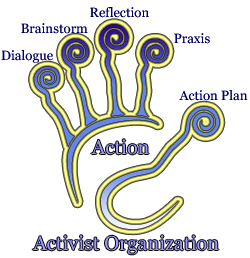
Nurse Activism
A Repository of Resources, Theory, and Tools for the Engaged Nurse
Nurse Activism
A Repository of Resources, Theory, and Tools for the Engaged Nurse
Step Three: Reflection
Taking Time to Contemplate
Reflection is an important step, since it allows the group to take time to consider all ramifications, restraining and driving forces, and be open to new ideas and possibilities that can be applied to the praxis and action planning steps.
Step Four: Praxis
Reflection in Action
Praxis is essentially the process of putting knowledge and reflection into action. It is an important step in tying all of the other steps together to facilitate a successful action plan that is both manageable and realistic yet also encompasses strategies to move beyond the restraints of risk, the tenets of status quo, and fear of failure.
Step Five: Action Planning
Outlining the Details
The final step to the Organizational Process pulls the other four steps together to provide the means for concrete initiative planning. This step entails determining the goals, strategies, timeline, resources, media scope, key players, and contingency considerations needed to move to the Action phase of the activist process.
Getting Organized
Every worthwhile change, cause, and activist initiative begins with the ideas and motivation of one person, who then shares the idea with like-minded folk who support and are motivated to join the initiator in organizing a plan of action. With the advent of new technologies, this organization phase has become much more accessible, effortless, and prevasive in effect.
During the organization process, the involved participants need to engage in dialogue, brainstorming, reflection, praxis, and action planning. Even the most reactive unstructured efforts follow these steps in some form, even if the engaged people do not consciously apply them.
Step One: Dialogue
A Reciprocal Process
Dialogue is a reciprocal, equitable, mutual and respectful conversational exchange between participants that allows all to be heard, all aspects
of the topic is explored, and a sense of emerging "community" is catalyzed.
Step Two: Brainstorming
Taking Inventory
Brainstorming involves exploring the strengths, abilities, resources, and goals of the developing activist group. In this step of the process, the members determine the resources at hand, and take stock of what will be needed to begin the activist process.

Dialogue can transform communication within groups of people. It represents a new way to look at how groups of people think, make decisions and choices, and how they work together - it brings people together in new ways.